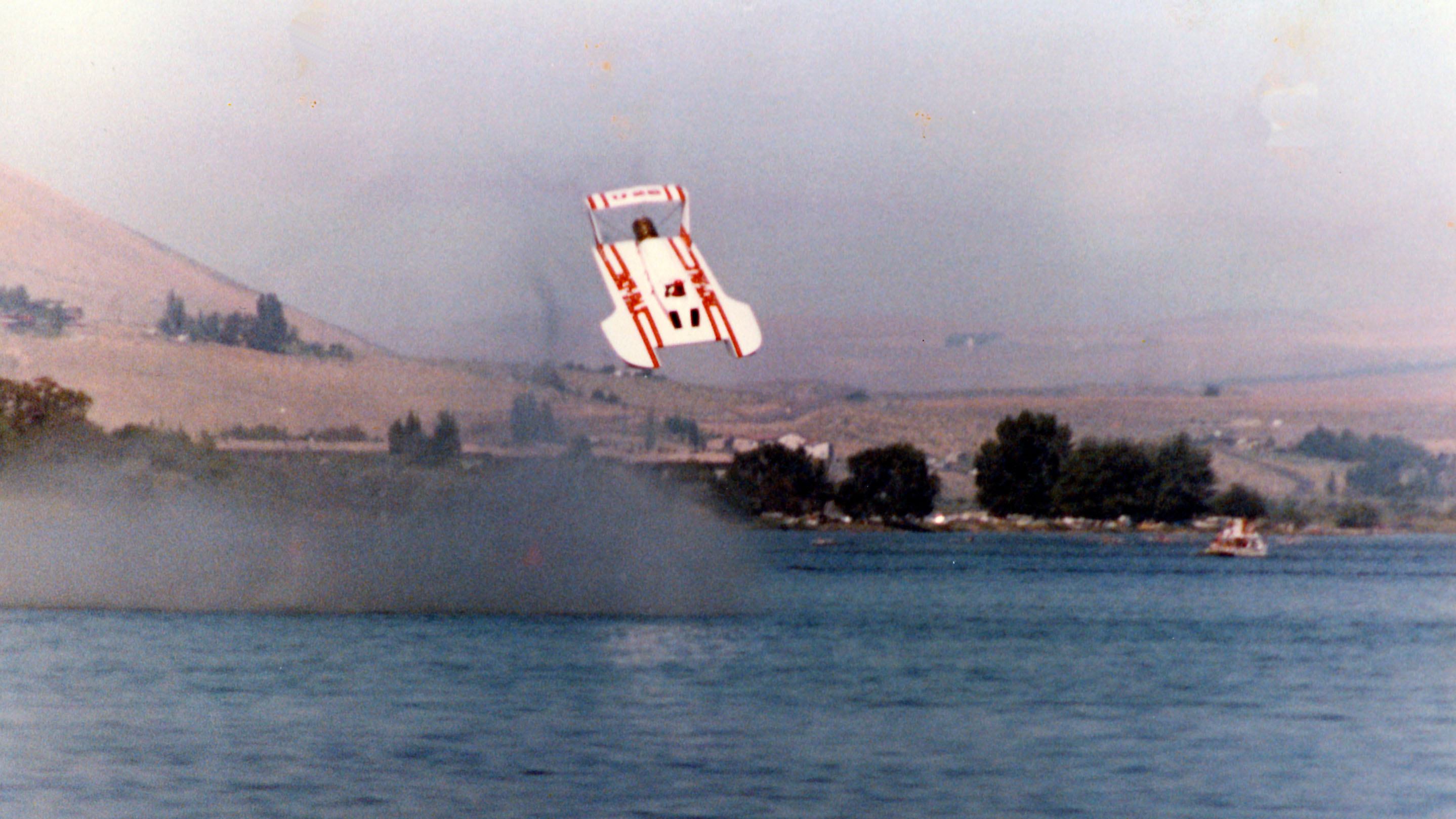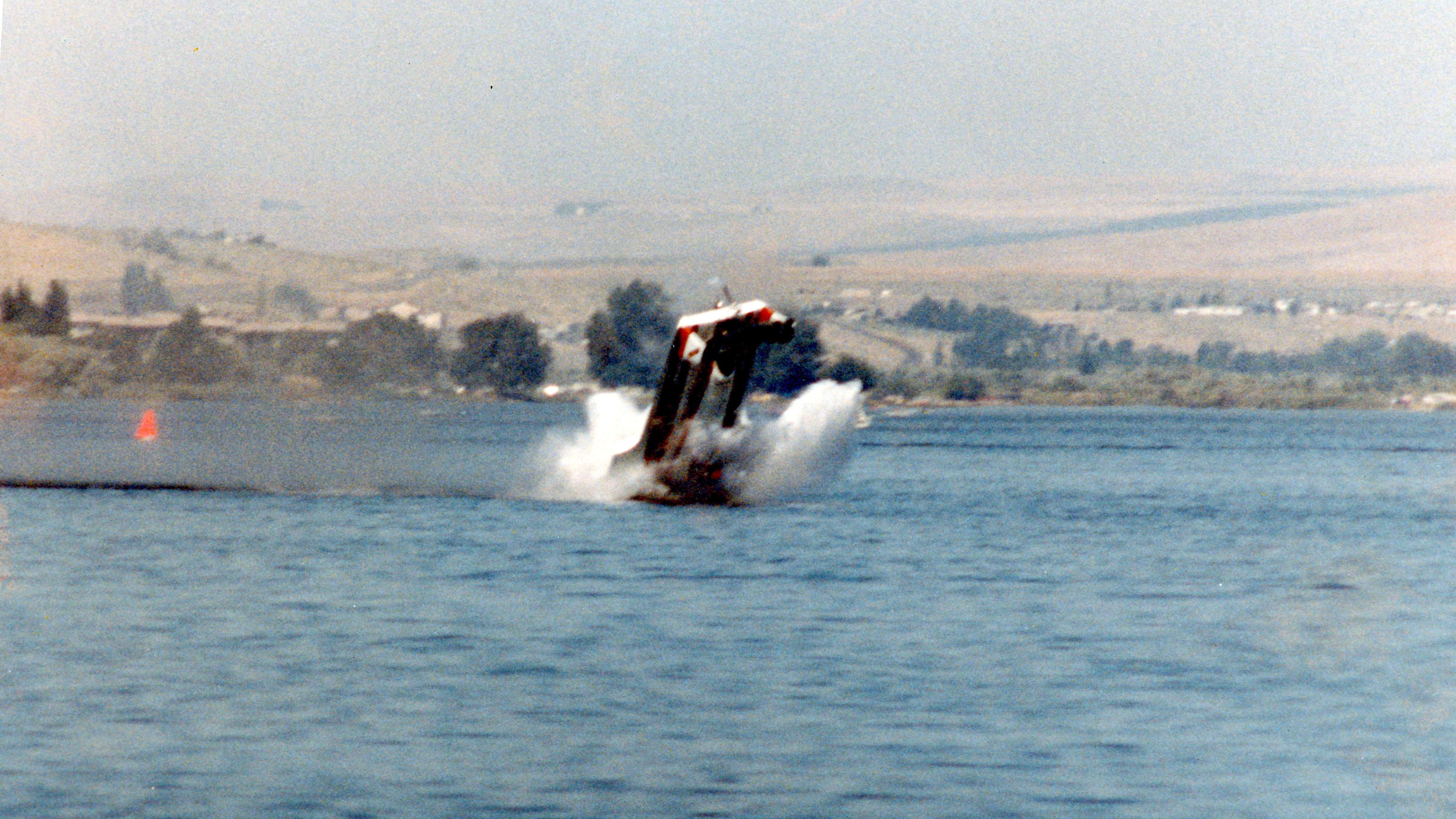1980 Columbia Cup
Pak Does Double Flip On Columbia
by Craig Smith, Times staff reporter


PASCO — The Pak isn't back anymore. It's on the shelf until next season and its rookie driver, John Walters, is in the hospital.
Walters, suffered multiple injuries yesterday in a double, end-over-end flip while testing the turbine-powered unlimited hydroplane before the Columbia Cup race.
Walters is in stable condition in Kennewick General Hospital with a fractured left hip socket and sprains to his left shoulder, elbow and knee.
Bill Muncey, piloting the Atlas Van Lines, was the upset winner of the race run on the Columbia River.
The Pak has been retired from racing until next season by Dave Heerensperger, chairman of the board of Pay 'N Pak, Inc. He attributed the accident to an improper adjustment on the boat's rear stabilizing wing, and Walters' overeagerness. Walters had been scheduled to start his unlimited career in Heat 1A at noon.
Heerensperger said the new boat "went a little too fast too early."
From his hospital bed last night, Walters recalled the accident: "I was timing my start. I was getting after the boat pretty hard and watching my stopwatch.
I felt it get a little light. It kind of came up and I came off the throttle a little bit. The boat just hung there a long, long time. Then finally I felt the back end drop a little bit and the nose stick up and I knew it was going over.
"I was conscious of the whole thing. I remember trying to bury myself in the cockpit as much as possible. I remember there was a lot of pressure actually holding me in the seat. I remember the water coming around twice. I was kind of pitched out of the boat when the boat hit the water upside down and backwards at the end of the 2½ times. It came down hard on one sponson and that's when I fell out of it."
Walters, 27, of Renton, was traveling about 160 miles an hour down the front straightaway at 10:40 a.m. when the boat went airborne. The 2½ rotations in the air is the most ever by an unlimited. It showed how light the boat is compared with other hydros.
Heerensperger said, "I just think the wing wasn't adjusted properly ... It just flew. It's so light."
Jim Lucero, Pak crew chief, said he didn't expect Walters "to go quite that hard.
"I asked him to go out and take it easy, not get himself in any precarious position."
Lucero was so confident of the run that he remained on the pit dock and did not see the flip.
But Walters maintained that he wasn't going faster than planned. He said he had run two straightaways at 160 m.p.h. before the accident occurred.
Walters responded "possibly" when asked if the whole Pak camp had pushed itself too hard to get the boat launched and into the race. The boat was first tested Thursday in Seattle.
"That's a hard question to answer," Walters said. "I felt comfortable going that fast. It really didn't give me any warning that it was going to happen."
Walters admitted that if he had had more practice time in the boat, he might have been able to detect some signal and avoid the accident.
"Most boats, after you learn them well, pretty much tell you what you can do and what you can't do," Walters said. "Maybe if I had been in it longer, I would have picked something up before the accident that would have warned me."
Heerensperger said he will withdraw the boat from the circuit for the rest of the season. A doctor said Walters will need at least six weeks for rehabilitation. He may require surgery for his hip fracture.
Heerensperger estimated the damage to the boat at about $30,000. Structural damage included a shredding of the tail wing and the shearing off of the right pickle-fork sponson.
Divers reached Walters 65 seconds after the flip. He had had the presence to signal he was conscious after hitting the water. The driver had high praise for the rescue team.
The boat was towed back to the pits upside down.
Heerensperger said by withdrawing from the circuit, the Pak preserves a year of its turbine eligibility. The Unlimited Racing Commission provisionally is allowing use of the helicopter turbine engine for four years.
"We don't use up a year of eligibility and we have four years starting next year because we did not race the boat," Heerensperger said. "We did not make an official start.
"We'll just put it in the barn and go out and test 20 to 30 times next year and make some-wing adjustments. We've got a few new ideas. We'll be very competitive."
Walters said he still is eager to drive the boat, although he admitted some second thoughts entered his mind after the accident.
"On the initial impact, it kind of sends thoughts through your mind like `what am I doing this to myself for?' " he said. "But Jim and David came back later on and we were talking about what changes we want to make and I found myself getting more and more involved in it. I'm really anxious to get back in it."
(Reprinted from The Seattle Times, July 28, 1980)
